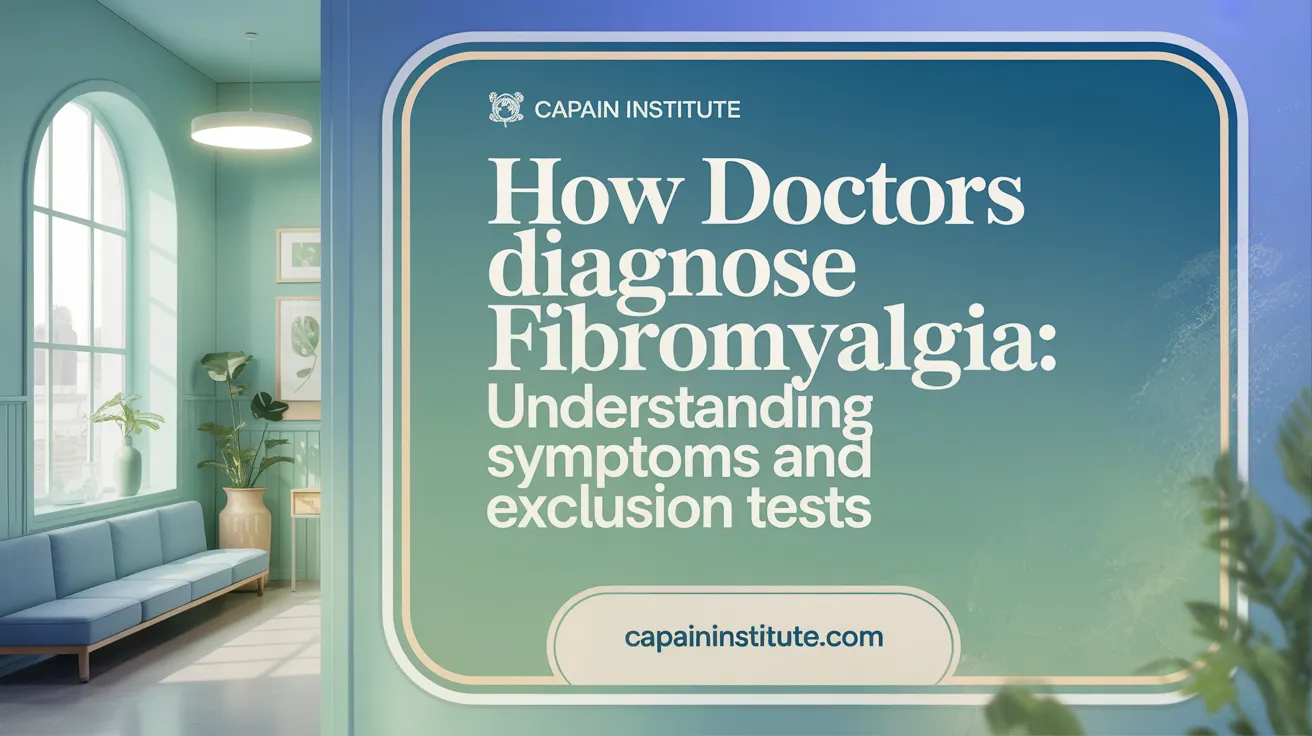An Overview of Fibromyalgia and Its Early Symptoms
Fibromyalgia is a chronic condition marked by widespread pain, fatigue, and a range of other physical and cognitive symptoms. Affecting an estimated 2-5% of the population, primarily women, it significantly impacts quality of life. Early recognition and management of fibromyalgia symptoms are crucial to improving patient outcomes. This article outlines the early signs of fibromyalgia and offers practical strategies for coping with this multifaceted disorder.
Identifying Early Signs and Symptoms of Fibromyalgia

What are the earliest signs of fibromyalgia?
Early signs of fibromyalgia typically include persistent, widespread pain lasting at least three months. Fatigue that remains despite restful sleep is also common. Cognitive difficulties, often called "fibro fog," affect concentration, memory, and mental clarity. Patients may experience nerve-related symptoms such as tingling or numbness in the hands and feet, muscle cramps, headaches, and sleep problems. These symptoms can appear gradually or following triggers like injury, surgery, infections, or emotional stress.
What symptoms are commonly experienced with fibromyalgia?
Fibromyalgia symptoms usually feature chronic, widespread pain throughout muscles and soft tissues, described as aching, burning, stabbing, or stiffness. Fatigue can be overwhelming and is often not relieved by sleep. Sleep disturbances such as insomnia, restless legs syndrome, and sleep apnea frequently occur. Cognitive impairments known as fibro fog lead to memory and attention problems. Other common symptoms include headaches, migraines, irritable bowel syndrome (IBS), anxiety, depression, and increased sensitivity to sensory stimuli including light and sound.
How is the widespread pain of fibromyalgia characterized?
The pain affects multiple body areas including the neck, shoulders, back, hips, and limbs, usually on both sides and above and below the waist. It is often constant and can vary in intensity. Patients report increased pain sensitivity, with even light touch causing discomfort, known as allodynia. The pain may feel like a dull ache, burning sensation, or sharp stabbing and is frequently worse in the morning or after physical activity.
What associated conditions and risk factors accompany fibromyalgia?
Fibromyalgia often coexists with other disorders such as temporomandibular joint (TMJ) disorders, chronic headaches, irritable bowel syndrome, anxiety, depression, restless legs syndrome, and chronic fatigue syndrome. Women are more commonly affected, especially those aged 30-50, with a family history increasing risk. Common triggers include infections, physical or emotional trauma, surgery, and ongoing stress. Individuals with other autoimmune or rheumatic conditions may be at greater risk of developing fibromyalgia.
Understanding the Causes and Risk Factors of Fibromyalgia

What causes fibromyalgia and who is at risk?
Fibromyalgia is a chronic condition marked by widespread pain and fatigue. Though its exact cause remains unclear, it is largely attributed to abnormal processing of pain signals by the central nervous system. This includes changes in neurotransmitter levels such as serotonin and norepinephrine, which contribute to heightened pain sensitivity and persistence.
Genetics also influence the development of fibromyalgia, as it tends to run in families. Environmental factors like infections, physical injury, and emotional stress can act as triggers, sometimes initiating or worsening symptoms (Fibromyalgia risk factors).
Women, particularly those aged between 30 and 50, are more commonly affected. Additional risk factors include a history of rheumatic diseases like rheumatoid arthritis and lupus, other chronic conditions such as depression, and lifestyle stresses (Fibromyalgia prevalence in women, Fibromyalgia and mental health).
Common triggers for symptom flare-ups include emotional stress, hormonal fluctuations, poor sleep quality, changes in medication, and weather variations (Fibromyalgia and flare-up triggers). Understanding these factors can help patients and healthcare providers better manage and reduce fibromyalgia symptoms.
| Aspect | Details | Notes |
|---|---|---|
| Pathophysiology | Altered central pain processing and neurotransmitter imbalances | Leads to increased pain sensitivity (Pain processing in fibromyalgia) |
| Genetic Contribution | Familial trends and gene influences | Suggests hereditary predisposition (Genetic factors in fibromyalgia |
| Environmental Triggers | Infections, trauma, emotional stress | Can initiate or exacerbate symptoms (Stress and fibromyalgia |
| At-Risk Groups | Women, ages 30-50, chronic illness history | Women more affected, chronic illnesses often co-occur (Fibromyalgia prevalence in women |
| Symptom Triggers | Stress, hormone changes, sleep disturbances, weather changes | Common causes of flare-ups (Fibromyalgia triggers) |
Diagnosis: How Fibromyalgia is Identified

Diagnostic Criteria
Fibromyalgia diagnosis centers on experiencing widespread pain in multiple body regions for at least three months. Pain must occur on both sides of the body, above and below the waist, affecting areas such as the left and right upper and lower regions, as well as the axial (spine) region. This pattern helps distinguish fibromyalgia from other conditions.
Role of Physical Exams and Medical History
Doctors rely on detailed patient history and physical examinations to identify characteristic symptoms like persistent widespread pain and tender points. The exam focuses on assessing pain presence and tenderness, alongside related symptoms such as fatigue, sleep disturbances, and cognitive difficulties often reported by patients.
Exclusion of Other Conditions
Since fibromyalgia shares symptoms with diseases like rheumatoid arthritis, lupus, and chronic fatigue syndrome, blood tests and imaging may be performed to rule out these conditions. These tests help ensure appropriate diagnosis by excluding other causes of chronic pain and fatigue.
Challenges in Diagnosis
Fibromyalgia lacks a specific laboratory test or biomarker, making diagnosis reliant on symptom patterns and exclusion of other illnesses. Symptoms overlap with various disorders, and some early fibromyalgia signs like fatigue and “fibro fog” can be subtle or mistaken for other issues. This complexity causes significant delays, often averaging several years, before a definitive diagnosis is made.
| Aspect | Details | Purpose/Notes |
|---|---|---|
| Symptom Duration | Pain lasting ≥3 months | Ensures chronic widespread nature |
| Pain Location | Both sides, above and below waist, and axial region | Distinguishes fibromyalgia from localized pain disorders |
| Physical Exam | Tender points assessment | Helps confirm pain sensitivity |
| Medical History | Review of symptoms and triggers | Identifies symptom patterns and potential triggers |
| Exclusion Tests | Blood work, imaging | Rules out rheumatoid arthritis, lupus, chronic fatigue syndrome |
| Diagnostic Challenges | No definitive lab test; symptom overlap | Leads to diagnostic delays and need for expert evaluation |
Sources for further information include Mayo Clinic Fibromyalgia Symptoms and Causes, Cleveland Clinic Fibromyalgia Overview, and NHS Fibromyalgia Symptoms.
Effective Approaches to Managing Fibromyalgia Symptoms

What treatment options are available for managing fibromyalgia symptoms?
There is no cure for fibromyalgia, but a combination of treatments can effectively manage symptoms. FDA-approved medications specifically for fibromyalgia include pregabalin, duloxetine, and milnacipran. These help reduce pain, improve sleep quality, and alleviate related anxiety or depression. Physicians also use other drugs such as muscle relaxants, tramadol, and various antidepressants to target different symptoms.
Medications approved and used in treatment
- Pregabalin relieves pain, anxiety, and sleep problems.
- Duloxetine and milnacipran are antidepressants helping both pain and mood symptoms.
- Muscle relaxants (like cyclobenzaprine) and tramadol may be added to ease muscle tension and pain.
- Other antidepressants (SSRIs, TCAs) assist with mood and sleep disturbances.
Non-pharmacological therapies
Psychological therapies such as cognitive-behavioral therapy (CBT) and acceptance and commitment therapy (ACT) help patients cope with chronic pain and emotional stress. Complementary therapies like acupuncture and massage therapy can provide additional relief and improve quality of life. Patient education and support groups further empower self-management.
Exercise and lifestyle adaptations
Regular, gentle exercise like walking, tai chi, and yoga improves physical function, reduces fatigue, and can lower pain levels over time. Activities should be tailored and gradually increased to avoid flare-ups. Lifestyle adjustments including pacing daily activities and using ergonomic strategies can reduce strain and enhance comfort.
Stress and sleep management techniques
Since stress can worsen symptoms, stress reduction methods such as meditation, relaxation exercises, and pacing oneself are crucial. Establishing consistent sleep hygiene—such as fixed bedtimes, a dark and quiet sleep environment, and avoiding stimulants like caffeine—helps combat fatigue and pain exacerbations.
Together, these multidisciplinary strategies form an effective approach to managing fibromyalgia, focusing on symptom relief and improving quality of life through medications, therapy, exercise, and self-care.
Practical Tips for Coping with Fibromyalgia Daily

How can individuals cope with fibromyalgia in daily life?
Coping with fibromyalgia requires a combination of self-care strategies and lifestyle adjustments to manage symptoms effectively.
Self-care strategies
Stress reduction plays a significant role. Techniques such as yoga for fibromyalgia, meditation for fibromyalgia, and deep breathing exercises can help lower stress levels, which often trigger symptom flare-ups. Maintaining a consistent sleep schedule and creating a peaceful, dark, and cool bedroom environment improve sleep quality, essential because fibromyalgia fatigue often persists despite rest. Engaging in gentle, regular physical activity like walking or tai chi for fibromyalgia reduces pain and stiffness and boosts mood. Keeping a daily journal helps track symptoms and identify individual triggers, aiding in managing "fibro fog" and cognitive challenges.
Lifestyle modifications
Adopting a balanced diet, rich in vegetables and antioxidants, supports overall health. Limiting caffeine intake may reduce anxiety and improve sleep quality. Pacing daily activities to avoid overexertion prevents worsening symptoms. Incorporating rest periods and listening to one’s body are crucial (Managing fibromyalgia symptoms).
Support resources
Open communication with family, friends, and healthcare providers builds a network of understanding and assistance. Joining fibromyalgia support groups offers emotional comfort and practical advice from others experiencing fibromyalgia.
Importance of patient education and communication
Understanding fibromyalgia empowers individuals to make informed choices about treatments and lifestyle changes. Transparent conversations with healthcare professionals allow for personalized management plans and adaptations as symptoms evolve (Fibromyalgia diagnosis and management).
Living Better with Fibromyalgia
While fibromyalgia presents complex challenges, early recognition and a comprehensive management plan can significantly improve quality of life. Understanding the early signs enables timely diagnosis and intervention. Combining medication, therapy, lifestyle changes, and self-care empowers individuals to manage symptoms effectively. Ongoing communication with healthcare providers and supportive networks is vital. Although there is no cure, embracing a holistic approach helps those affected navigate fibromyalgia's ups and downs, promoting resilience and a better day-to-day experience.
